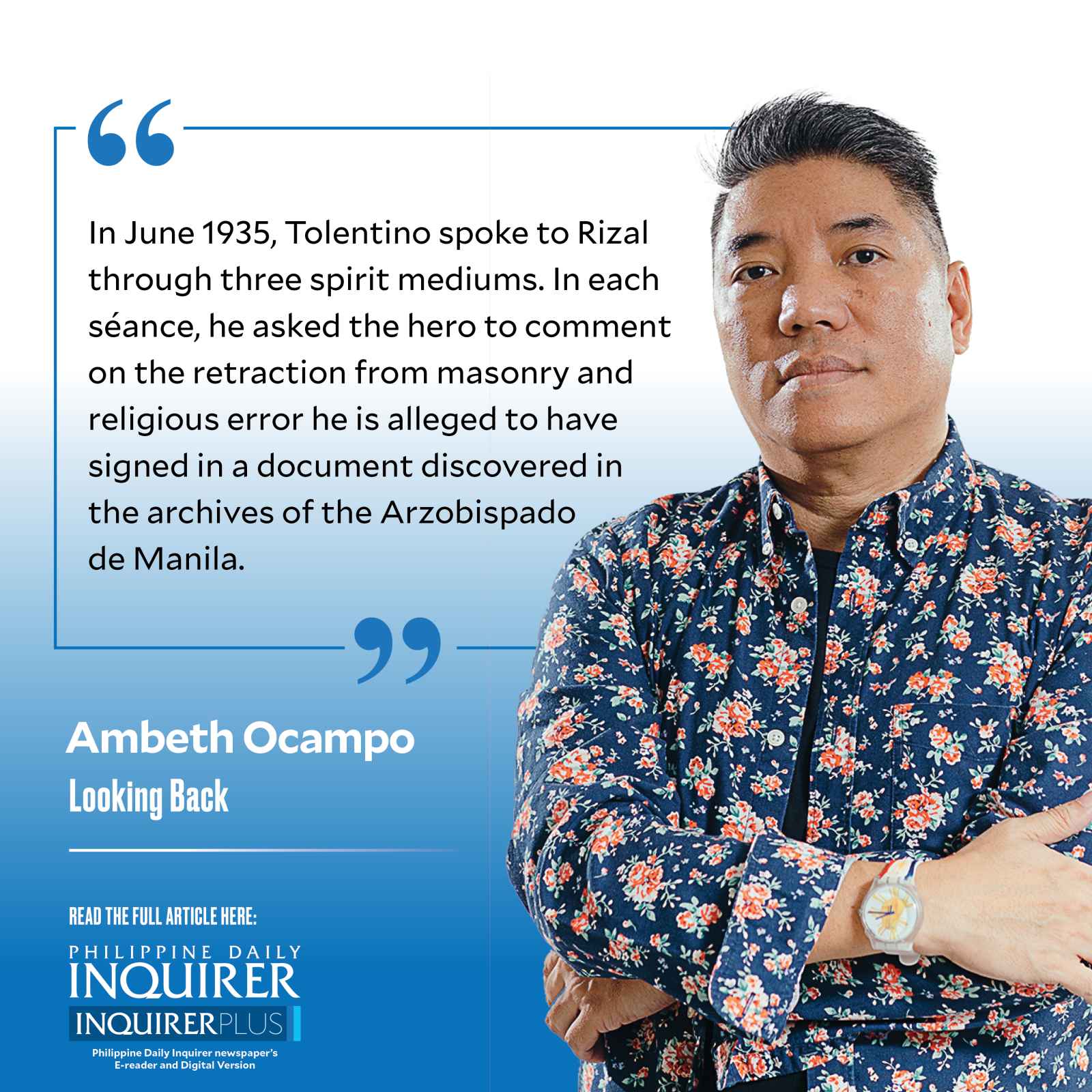
Deirdre de la Cruz of the University of Michigan and I share a common interest in Guillermo E. Tolentino. As National Artist for Sculpture, everyone recognizes his iconic works like the University of the Philippines’ “Oblation” and the Bonifacio monument in Caloocan, which gave rise to “Monumento” as a destination. What is not well-known is that Tolentino was a founding member of the Union Espiritista Cristiana de Filipinas. Séances and paranormal activity was routine in Tolentino’s home on Retiro Street, Sampaloc, Manila, where physical objects or “aportos” would fall from the spirit world into ours.
Tolentino published an obscure book, “Si Rizal” (1957), which documents conversations with Rizal from beyond the grave. In June 1935, Tolentino spoke to Rizal through three spirit mediums. In each séance, he asked the hero to comment on the retraction from masonry and religious error he is alleged to have signed in a document discovered in the archives of the Arzobispado de Manila. Rizal vehemently denied the authenticity of the document. Translated from the original Tagalog transcript Rizal declared:
“I don’t know why my enemies persist in persecuting me even if I have long left the earth. I am telling you that the retraction they say is mine, is not mine. It is fake. You as an artist can easily create one of these. Why will I sign a retraction when I never turned my back on truth? I turned my back on darkness, ignorance, superstition, and wrong faith …”
On Jan. 25, 1948, Rizal spoke to his younger sister Trinidad through the medium Felicidad Lopez and a full transcription is made available in Tolentino’s book. He said in part:
“Allow me in these moments, one who is without a body to talk to you … allow me to speak in Tagalog because there is nothing more beautiful than to communicate with one’s sister under the vast skies of the Philippines in the beautiful language of the Filipinos.”
Rizal even took a swipe at government officials who spoke in a foreign language describing them as “slaves aping the language of colonial masters.” Then commenting on religion, Rizal declared: “It is sad that my countrymen for whom I gave my life in order to enlighten them are still slaves to the ignorance and superstition that comes from the uneducated and ignorant people who head the churches … These heads of churches who, instead of uniting people, sow dissent by claiming the exclusive right to truth.”
Surely, there is more where this came from, but the most intriguing part of Tolentino’s practice were “spirit photographs.” One of them, reproduced in a 1976 biography by Rodolfo Paras-Perez, depicts the face of a departed woman that appeared on a piece of cloth, a 3D version better than the two-dimensional Shroud of Turin. Tolentino’s spirit photograph prompted De la Cruz to send me her fascinating journal article, “To which earthly categories do not apply: Spirit photography, Filipino Ghosts, and the Global Occult at the Turn of the Twentieth Century” (2017), contextualizing the “Album de fotografias espirititstas” (Barcelona, 1903).
Compilations of spirit photographs, then and now, are quite rare. What makes this one exceptional is that the first 10 of the 37 spirit photographs reproduced were taken in the Manila studio of Joaquin Reyes at the turn of the century, and feature the spirit medium Jose Azas. In a number of photos, Azas, in a trance with palms resting on a small round table, conjures a spirit that then appears like a haze or a “columna fluidica.” The caption to one photo explained that the conjured spirit was prematurely photographed before it could fully assume human form.
In another photo, Azas conjures a spirit in the presence of the former Augustinian friar Salvador Pons from whom four photographs in the book were sourced. The most amazing photo in the volume was that taken of Don N. Javier, a widower who sought solace from Father Pons who referred him to the medium Jose Azas. The spirit of Javier’s wife appears like a transparent cloud forming the silhouette of a woman in a baro’t saya. Javier was able to recognize the haze as his departed wife even if the photographed spirit was headless! Historically, the most exciting photograph shows Father Pons seated with his palms on his knees, a haze before him. The caption identified the spirit as that of three priests, friends of Father Pons, who were sentenced to death by garrote. It goes on to say that “The fluidic cloud is intense, although the profiles of those invoked lack clarity. On the back of the rug beside Father Pons is the outline of a cassock.” The reason given for the inability of Fathers Mariano Gómes, José Burgos, and Jacinto Zamora to materialize completely was that they had not moved on from their terrible death. Transcripts or a report of what Gomburza said at the séance remains to be found.
—————–
Comments are welcome at aocampo@ateneo.edu